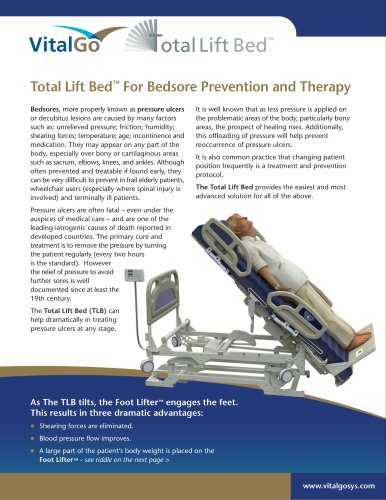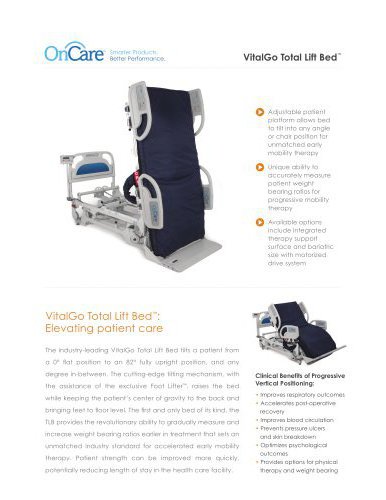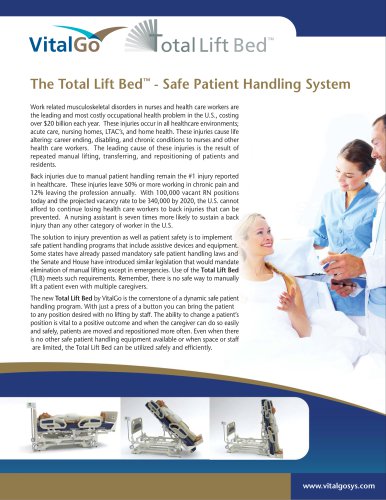
Catalog excerpts

Total Lift Bed™ For Bedsore Prevention and Therapy Bedsores, more properly known as pressure ulcers or decubitus lesions are caused by many factors such as: unrelieved pressure; friction; humidity; shearing forces; temperature; age; incontinence and medication. They may appear on any part of the body, especially over bony or cartilaginous areas such as sacrum, elbows, knees, and ankles. Although often prevented and treatable if found early, they can be very difficult to prevent in frail elderly patients, wheelchair users (especially where spinal injury is involved) and terminally ill patients. It is well known that as less pressure is applied on the problematic areas of the body, particularly bony areas, the prospect of healing rises. Additionally, this offloading of pressure will help prevent reoccurrence of pressure ulcers. It is also common practice that changing patient position frequently is a treatment and prevention protocol. The Total Lift Bed provides the easiest and most advanced solution for all of the above. Pressure ulcers are often fatal – even under the auspices of medical care – and are one of the leading iatrogenic causes of death reported in developed countries. The primary cure and treatment is to remove the pressure by turning the patient regularly (every two hours is the standard). However the relief of pressure to avoid further sores is well documented since at least the 19th century. The Total Lift Bed (TLB) can help dramatically in treating pressure ulcers at any stage. As The TLB tilts, the Foot Lifter™ engages the feet. This results in three dramatic advantages: G Shearing forces are eliminated. Blood pressure flow improves. A large part of the patient’s body weight is placed on the Foot Lifter™ - see riddle on the next page >
Open the catalog to page 1
Total Lift Bed™ For Bedsore Prevention and Therapy Riddle – A patient weighing 86 kg. (190 Lbs.) lies on a bed. What is the body weight distributed on the support surface? Answer – 86 kg. (190 lbs.) (This is easy) The patient is tilted and the feet are placed on the Foot Lifter. The foot lifter scale shows 54 kg. (120 lbs.) What is the amount of weight distributed on the support surface now? K 86 kg. (190 lbs.) K 54 kg. (120 Lbs.) Yes – using the tilting position will decrease the amount of weight/pressure distributed on the support surface. What could be better for wound therapy? The...
Open the catalog to page 2All VitalGo Systems Ltd. catalogs and technical brochures
-
Oncare USA TLB
2 Pages
-
APX Brazil TLB
2 Pages
-
TLBB Overview Short Leaflet
2 Pages
-
TLB Overview Short Leaflet
2 Pages







